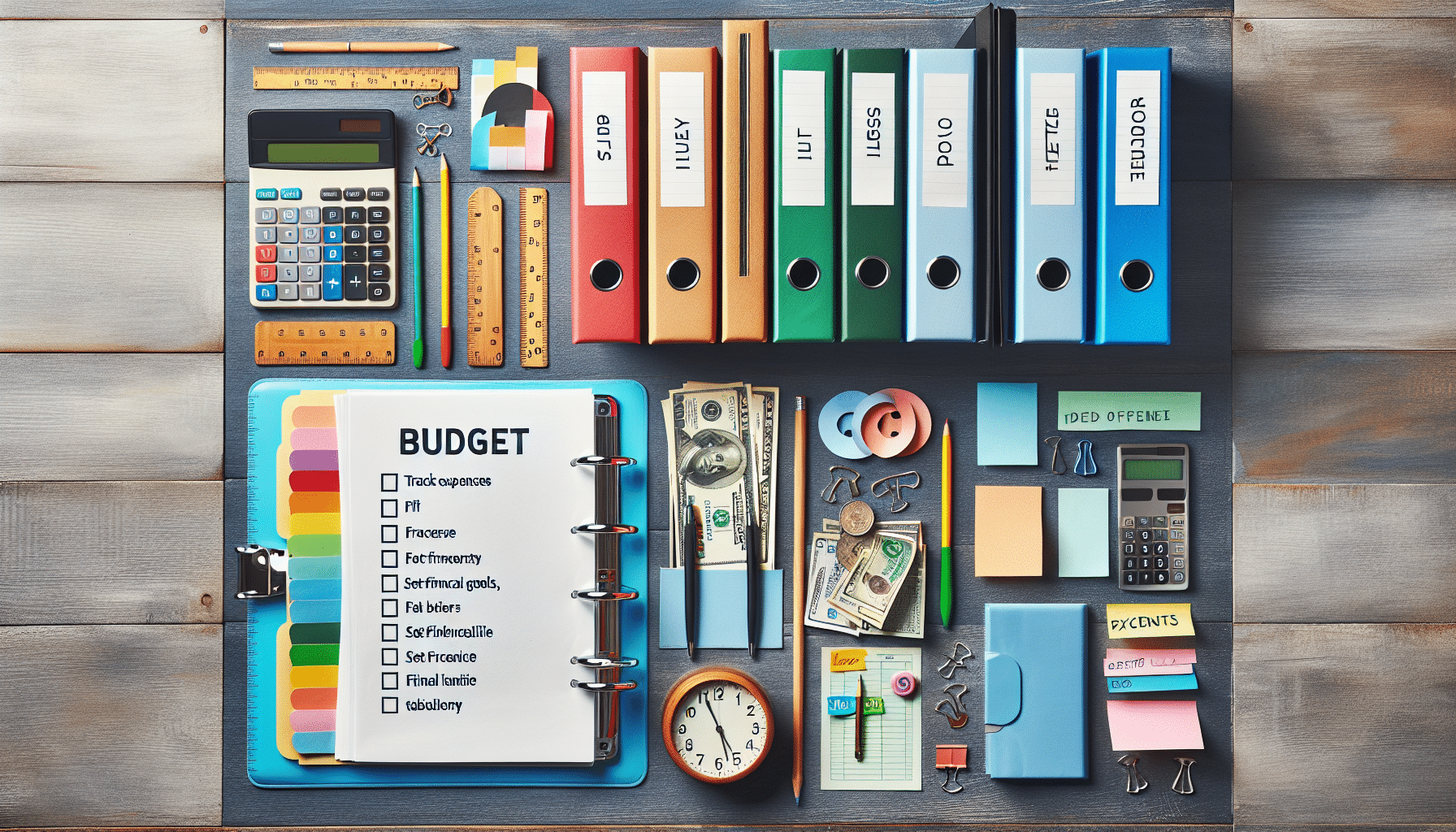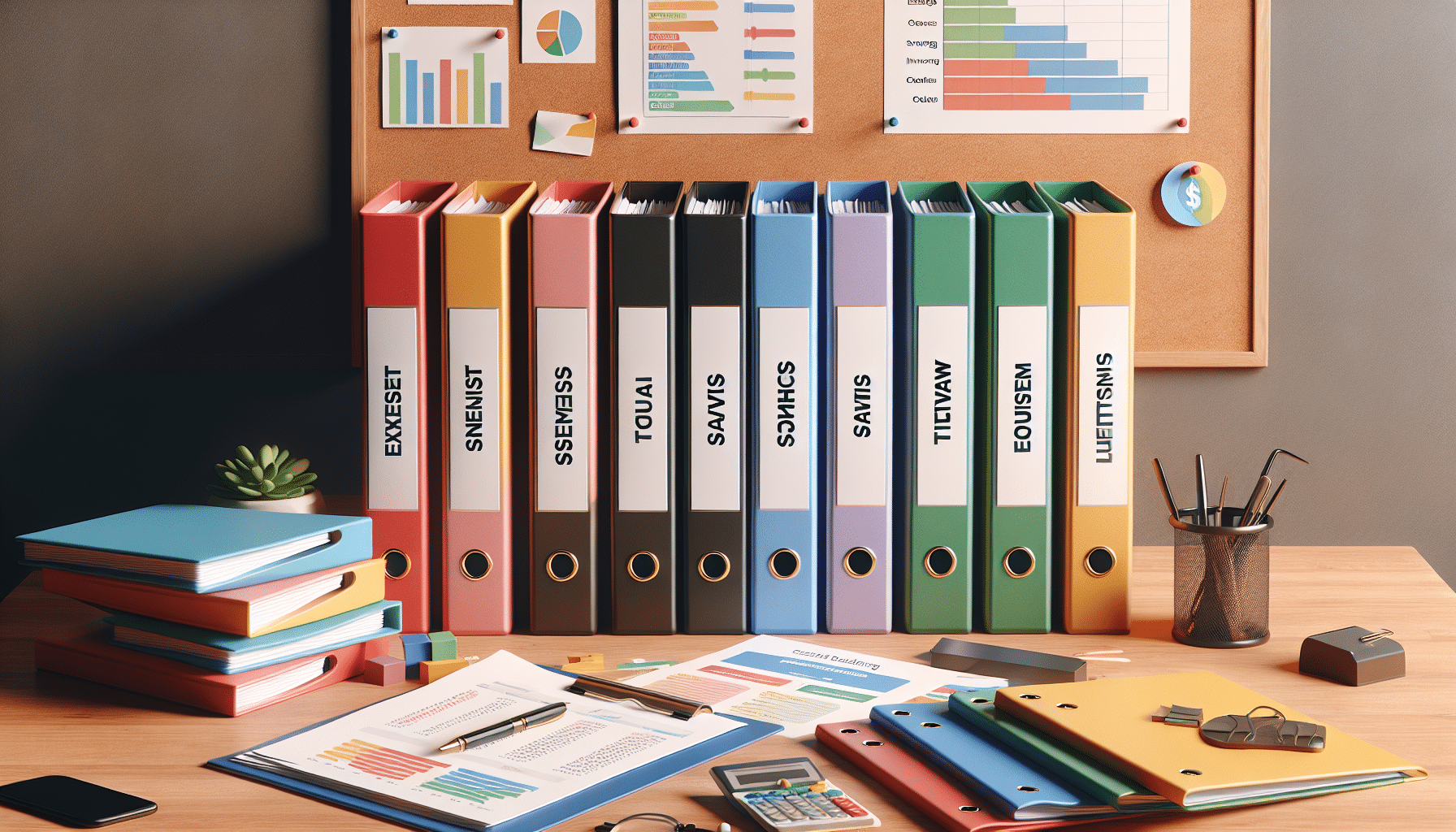Are you tired of feeling overwhelmed and disorganized when it comes to managing your finances? Look no further, because we've got the solution for you: a budget binder. In this article, we will guide you through the simple steps of creating your own budget binder, allowing you to take control of your money and achieve your financial goals. With helpful tips and resources, you'll soon be on your way to financial success. So let's get started on creating your very own budget binder!

This image is property of pixabay.com.
Gathering Supplies for Your Budget Binder
Selecting a Binder
When it comes to creating your budget binder, the first step is to select the perfect binder. Look for one that is sturdy and durable, as it will likely be handling a lot of pages and documents. Choose a binder that has plenty of pockets or sleeves to hold your items securely. Additionally, consider the size of the binder - a standard size that can accommodate letter-sized paper is usually the most practical choice.
Choosing Dividers
Dividers are an essential component of your budget binder as they help you organize your financial documents and resources. Consider using dividers with customizable tabs so you can label them according to your specific budget categories. It's important to have enough dividers to separate your different sections effectively and make finding information a breeze.
Purchasing Sheet Protectors
Sheet protectors are a valuable addition to your budget binder as they keep your important documents safe from wear and tear. Opt for top-loading sheet protectors to make it easy to insert and remove your papers as needed. These clear plastic sleeves also ensure that your documents remain easily readable and protected from potential damage.
Obtaining Plastic Pockets
Plastic pockets are a handy tool to have in your budget binder as they provide extra storage space for loose items such as small receipts, business cards, or notes. These pockets come in various sizes, so choose ones that fit your needs. Just like the sheet protectors, plastic pockets keep your items secure and prevent them from getting lost or damaged.
Determining Budget Categories
Analyzing Your Spending
To effectively budget, you first need to analyze your spending habits. Take a close look at your bank statements, credit card bills, and receipts from the past few months. Categorize your expenses into groups such as housing, transportation, groceries, dining out, entertainment, utilities, and more. This analysis will give you a clear understanding of where your money is going and help you identify areas where you can potentially cut back.
Identifying Fixed Expenses
Fixed expenses are those that remain the same each month, like rent or mortgage payments, car payments, insurance premiums, and subscription services. Identify all your fixed expenses and list them separately in your budget binder. It's important to be accurate with these amounts as they are predictable and important for your long-term financial plans.
Listing Variable Expenses
Variable expenses are the costs that vary from month to month, such as groceries, dining out, entertainment, clothing, and personal care items. Create a section in your budget binder to record and track these expenses. It may be helpful to average out your spending over the past few months to determine a reasonable budget for each variable category.
Including Savings and Debt Repayments
Saving money and managing debt are crucial aspects of budgeting. Allocate a section in your budget binder specifically for tracking your savings goals and debt repayments. Include your desired savings targets, debt balances, and repayment plans. By keeping these categories visible, you can actively work towards your financial goals and stay motivated.

This image is property of pixabay.com.
Creating Templates for Your Budget Binder
Designing a Monthly Budget Template
A well-designed monthly budget template is the foundation of your budget binder. Include spaces to input your income, fixed expenses, variable expenses, savings contributions, and debt repayments. Create a column for the actual amounts spent or saved to track your progress. This template will serve as a snapshot of your monthly budget and help you make informed financial decisions.
Developing Weekly Expense Trackers
Tracking your expenses on a weekly basis can provide a clearer picture of your spending habits. Create weekly expense trackers that allow you to record your variable expenses and compare them against your budget. This will help you identify any potential overspending early on and make adjustments as needed.
Crafting Savings Goal Sheets
Setting savings goals is a fundamental part of budgeting. Create savings goal sheets in your budget binder to outline your specific objectives and the amount of money you aim to save. Break down your goals into smaller increments to make them more attainable and rewarding. As you track your progress over time, these sheets will keep you motivated and focused on your financial targets.
Incorporating Debt Repayment Schedules
If you have outstanding debts, it's important to have a clear plan for repayment. Include debt repayment schedules in your budget binder to keep track of your debt balances, interest rates, and minimum payments. Utilize these schedules to develop strategies for paying off your debts more efficiently and to visualize your progress as you work towards becoming debt-free.
Organizing Financial Documents
Collecting Bills and Receipts
Gather all your bills and receipts and maintain a section in your budget binder specifically for these documents. You can quickly reference them when needed for expense tracking, verifying charges, or budget analysis. Keeping them organized will also simplify the process of filing taxes.
Gathering Bank and Credit Card Statements
Bank statements and credit card statements are essential for understanding your cash flow and tracking your expenses. Allocate a section in your budget binder to store these statements chronologically. Use a hole puncher to ensure they can be easily added to your binder without any risk of losing them.
Saving Tax-Related Documents
Tax season can be stressful, so having a designated section in your budget binder for tax-related documents can alleviate some of that anxiety. Store important documents such as W-2s, 1099s, and other tax forms in this section. Additionally, keep track of deductible expenses throughout the year to make tax preparation smoother.
Compiling Investment and Retirement Account Statements
If you have investment or retirement accounts, it's important to keep track of the statements and performance reports. Create a section in your budget binder to compile these documents. This will not only help you monitor your investments but also assist you in making informed decisions about your financial future.

This image is property of pixabay.com.
Designing Tracking Sheets
Tracking Income Sources
Monitoring your income sources is just as important as tracking your expenses. Develop tracking sheets to record all sources of income, including your salary, side gigs, investments, and any other revenue streams. By keeping a clear record of your income, you'll have a better understanding of your overall financial position.
Monitoring Fixed Expenses
Keeping an eye on your fixed expenses is crucial to ensure you don't overspend. Create tracking sheets for your fixed expenses, categorizing them by the due date or payment frequency. Utilize these sheets to see the cost of your fixed obligations throughout the year and plan accordingly.
Recording Variable Expenses
Variable expenses can easily get out of hand if not closely monitored. Construct tracking sheets to record and analyze your variable expenses. Categorize them based on your budget categories and update the sheets regularly. This will help you identify areas where you may need to cut back and make adjustments to stay within your budget.
Logging Savings and Debt Repayments
Tracking your savings contributions and debt repayments is an essential part of budgeting. Develop tracking sheets for savings and debt, listing the amount saved or paid down each month. By monitoring your progress, you'll stay motivated to continue saving and making progress towards your debt repayment goals.
Setting Budgeting Goals
Establishing Short-Term Goals
Short-term budgeting goals are those you aim to achieve within the next six to twelve months. These goals could include saving for a vacation, paying off a credit card, or building an emergency fund. Determine what is most important to you and set realistic short-term goals that align with your financial priorities.
Defining Long-Term Goals
Long-term budgeting goals encompass financial milestones that you want to achieve in three or more years. These goals might include saving for a down payment on a home, funding your child's education, or retiring comfortably. Define your long-term goals, break them down into manageable steps, and keep them visible in your budget binder as a reminder of what you're working towards.
Creating Action Plans
Once you have established your budgeting goals, it's time to create action plans to achieve them. Break down each goal into smaller, actionable steps. Outline deadlines, necessary resources, and specific actions you need to take to make progress. Implementing these action plans will ensure you're on track to reach your desired financial outcomes.

Implementing a Routine
Scheduling Budget Review Sessions
Consistency is key when it comes to budgeting. Schedule regular budget review sessions in your calendar to evaluate your progress and make any necessary adjustments. Whether it's weekly, bi-weekly, or monthly, having dedicated time to review your budget will help you stay on top of your finances and make informed financial decisions.
Updating Tracking Sheets Regularly
To accurately track your expenses and progress, it's crucial to update your tracking sheets regularly. Make it a habit to record any income, expenses, savings, and debt repayments as they occur. By consistently updating your tracking sheets, you'll have an up-to-date understanding of your financial situation and can easily identify any areas that require attention.
Adjusting Budget Categories as Needed
As your financial situation changes, you may need to adjust your budget categories. Life events, fluctuating expenses, or new financial goals can all require modifications to your budget. Regularly assess your budget categories to ensure they align with your current needs and make adjustments as necessary to stay on track.
Revising Goals on a Quarterly or Yearly Basis
Revisiting your budgeting goals periodically is essential to ensure they still align with your financial aspirations. Consider reviewing and revising your goals on a quarterly or yearly basis. This allows you to measure your progress, make adjustments, and set new goals that reflect changes in your circumstances or financial priorities.
Utilizing Technology for Budgeting
Exploring Budgeting Apps and Tools
In the digital age, there are numerous budgeting apps and tools available to help streamline your financial management. Explore different options and find an app or tool that suits your needs and preferences. Look for features such as expense tracking, goal setting, and budget visualization to assist you in managing your finances effectively.
Syncing Your Budget Binder with Digital Platforms
To combine the benefits of a physical budget binder with the convenience of technology, consider syncing your budget binder with digital platforms. Some apps and tools allow you to upload and organize your budget documents digitally, ensuring you have access to them anytime, anywhere. This integration can make budgeting more efficient and accessible.
Automating Expense Tracking
Automating your expense tracking can save you time and effort. Take advantage of features like transaction categorization and automatic expense imports offered by budgeting apps or banks. By automating this process, you can reduce the chances of overlooking expenses and ensure your budget remains accurate and up to date.

Maintaining Motivation and Accountability
Finding a Budgeting Buddy
Maintaining motivation can sometimes be challenging, so finding a budgeting buddy can be immensely helpful. Look for someone who shares similar financial goals and values and who can keep you accountable. Regularly check-in with your budgeting buddy, share progress updates, and provide support and encouragement to each other throughout your financial journeys.
Rewarding Yourself for Sticking to Your Budget
Rewarding yourself for sticking to your budget is an important part of maintaining motivation. Set up small, meaningful rewards for achieving financial milestones or staying within your budget for a specific period. These rewards could be as simple as treating yourself to a favorite meal, indulging in a small purchase, or enjoying a day off. Celebrating your successes will help you stay motivated and committed to your financial goals.
Seeking Support from Online Communities
If you find it difficult to stay motivated or need further encouragement, consider joining online budgeting communities. These communities provide a platform to connect with like-minded individuals who are also working towards financial stability. Share your experiences, seek advice, and provide support to others. Being part of a supportive community can make the journey towards financial success feel less daunting.
Troubleshooting and Problem-Solving
Addressing Unexpected Expenses
Unexpected expenses can easily throw off your budgeting efforts. It's important to be prepared and have a plan in place to address them. Consider setting up an emergency fund that can cover unexpected costs without derailing your financial goals. If an unexpected expense arises, assess the impact on your budget and make adjustments as needed to stay on track.
Dealing with Budgeting Setbacks
Budgeting setbacks are normal and happen to everyone. The key is to address them promptly and adjust your approach if necessary. Reflect on the reasons for the setback and find ways to overcome the challenges. Whether it's cutting back on expenses, finding additional sources of income, or revising your goals, adapt your budgeting strategy to overcome setbacks and continue making progress.
Identifying and Eliminating Budgeting Obstacles
Identifying and eliminating budgeting obstacles is essential to ensure your long-term budgeting success. Obstacles can vary from overspending habits to lack of financial organization or discipline. Take the time to assess potential obstacles you face, and develop strategies to overcome them. This might involve finding alternative ways to manage stress, implementing accountability measures, or seeking professional financial guidance. By proactively addressing obstacles, you'll increase your chances of maintaining a successful and sustainable budgeting routine.
In conclusion, creating a budget binder is a comprehensive and organized approach to managing your finances. By gathering the right supplies, determining budget categories, creating templates, organizing financial documents, designing tracking sheets, setting goals, implementing a routine, utilizing technology, maintaining motivation and accountability, and troubleshooting obstacles, you'll be well-equipped to take control of your financial journey. Be patient, stay consistent, and celebrate each milestone along the way. Your budget binder will serve as a valuable tool in achieving your financial goals and building a secure future.

